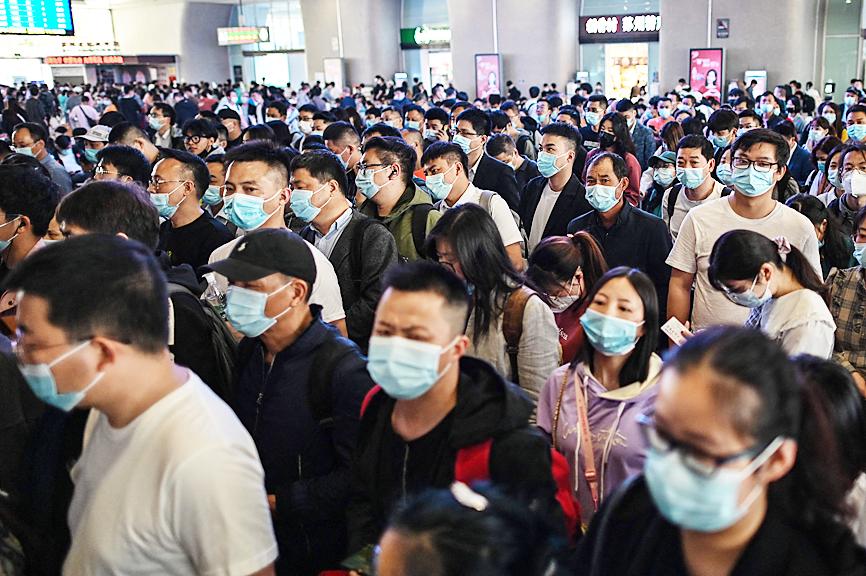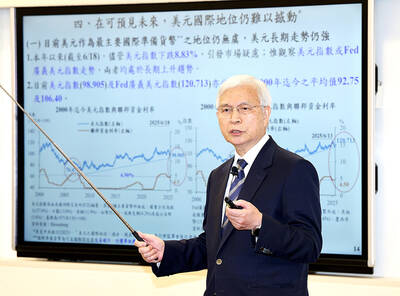China’s population grew last year, the National Statistic Bureau said yesterday, in an apparent bid to quash reports that it had fallen, but stopped short of saying from which year numbers had grown.
On Tuesday, the Financial Times said that China was set to report that its population fell below 1.4 billion last year from 2019, in the first decrease in five decades, citing people familiar with the matter.
The bureau has delayed publishing the results of last year’s once-in-a-decade census, with no explanation apart from saying more preparatory work was needed.

Photo: AFP
It had been due to announce the results early this month.
“According to our understanding, in 2020, our country’s population continued to grow,” the bureau said in a one-sentence statement, adding that detailed figures would be disclosed when the census results were published.
Births in China have continued to fall despite a two-child policy that replaced a decades-old one-child limit scrapped in 2016 in hopes of boosting the number of babies.
Last year, births plunged 15 percent to 10.035 million from 2019, the Chinese Ministry of Public Security has said.
The 2010 census showed the mainland population was 1.34 billion.
By 2019, this had increased to 1.4005 billion, the bureau said in February last year.
The bureau yesterday did not say if last year’s growth was being measured from 2019 or from 2010, which means the population could have still increased from the past decade, but declined from a year earlier.
“The census is very accurate, but the reason for the delay in publishing it may be that some of the speculation is correct,” said Liu Kaiming, a labor expert in the southern city of Shenzhen.
“The number of newborns released by the [Chinese] Ministry of Public Security is close to falling below 10 million; therefore, the population of 2020 may be less than 1.4 billion,” Liu said.
The population number is very sensitive and would not be released until government departments have reached a consensus on the data and its implications, the Financial Times said.
An unexpected drop in population would pile pressure on Beijing to quickly come up with measures to encourage people to have more children and avoid an irreversible decline.
State media have in the past few months said the population might start to shrink in the next few years.
In 2016, Beijing set a target to increase the population to about 1.42 billion by last year.
The last time the Chinese population fell was in 1959 to 1961, during Mao Zedong’s Great Leap Forward campaign.
During the period, the population shrank 13.48 million, bureau data showed, amid a famine caused by the disastrous economic policy.

DIVIDED VIEWS: Although the Fed agreed on holding rates steady, some officials see no rate cuts for this year, while 10 policymakers foresee two or more cuts There are a lot of unknowns about the outlook for the economy and interest rates, but US Federal Reserve Chair Jerome Powell signaled at least one thing seems certain: Higher prices are coming. Fed policymakers voted unanimously to hold interest rates steady at a range of 4.25 percent to 4.50 percent for a fourth straight meeting on Wednesday, as they await clarity on whether tariffs would leave a one-time or more lasting mark on inflation. Powell said it is still unclear how much of the bill would fall on the shoulders of consumers, but he expects to learn more about tariffs

NOT JUSTIFIED: The bank’s governor said there would only be a rate cut if inflation falls below 1.5% and economic conditions deteriorate, which have not been detected The central bank yesterday kept its key interest rates unchanged for a fifth consecutive quarter, aligning with market expectations, while slightly lowering its inflation outlook amid signs of cooling price pressures. The move came after the US Federal Reserve held rates steady overnight, despite pressure from US President Donald Trump to cut borrowing costs. Central bank board members unanimously voted to maintain the discount rate at 2 percent, the secured loan rate at 2.375 percent and the overnight lending rate at 4.25 percent. “We consider the policy decision appropriate, although it suggests tightening leaning after factoring in slackening inflation and stable GDP growth,”

Meta Platforms Inc offered US$100 million bonuses to OpenAI employees in an unsuccessful bid to poach the ChatGPT maker’s talent and strengthen its own generative artificial intelligence (AI) teams, OpenAI CEO Sam Altman has said. Facebook’s parent company — a competitor of OpenAI — also offered “giant” annual salaries exceeding US$100 million to OpenAI staffers, Altman said in an interview on the Uncapped with Jack Altman podcast released on Tuesday. “It is crazy,” Sam Altman told his brother Jack in the interview. “I’m really happy that at least so far none of our best people have decided to take them

As they zigzagged from one machine to another in the searing African sun, the workers were covered in black soot. However, the charcoal they were making is known as “green,” and backers hope it can save impoverished Chad from rampant deforestation. Chad, a vast, landlocked country of 19 million people perched at the crossroads of north and central Africa, is steadily turning to desert. It has lost more than 90 percent of its forest cover since the 1970s, hit by climate change and overexploitation of trees for household uses such as cooking, officials say. “Green charcoal” aims to protect what